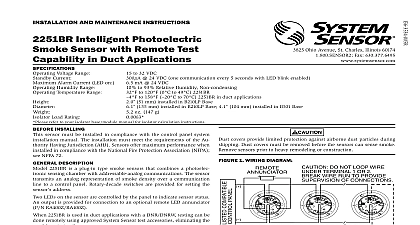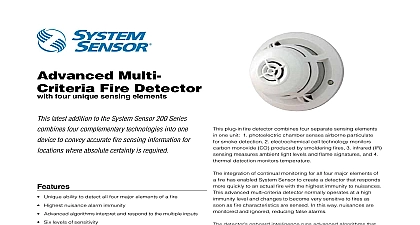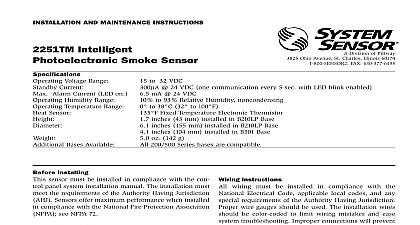System Sensor 2251-COPTIR Manual

File Preview
Click below to download for free
Click below to download for free
File Data
| Name | system-sensor-2251-coptir-manual-3679841250.pdf |
|---|---|
| Type | |
| Size | 921.29 KB |
| Downloads |
Text Preview
I AND MAINTENANCE INSTRUCTIONS Intelligent Photoelectric Smoke Sensor 3825 Ohio Avenue St Charles Illinois 60174 FAX 630 377 6495 Voltage Range Current Alarm Current LED on Humidity Range Temperature Range to 32 VDC 24 VDC one communication every 5 sec with LED blink enabled mA 24 VDC to 93 Relative Humidity Non condensing to 38 32 to 100 69 mm installed in B210LP Base 155 mm installed in B210LP Base 4.0 102 mm installed in B501 Base oz 130 g INSTALLINg sensor must be installed in compliance with the control panel system manual The installation must meet the requirements of the Having Jurisdiction AHJ Sensors offer maximum performance installed in compliance with the National Fire Protection Association see NFPA 72 DESCRIPTION 2251 COPTIR is a plug in type smoke sensor that is a photoelectronic chamber combined with carbon monoxide CO thermal infra red sensors and addressable analog communications The sensors transmit analog representation of smoke density over a communication line to a panel Rotary decade switches are provided for setting the sensor LEDs on the sensor are controlled by the panel to indicate sensor sta An output is provided for connection to an optional remote LED an P N RA100Z RA400Z 2251 COPTIR requires compatible addressable communications to properly Connect these sensors to listed compatible control pan only Sensor recommends spacing sensors in compliance with NFPA 72 low air flow applications with smooth ceilings space sensors 30 feet For specific information regarding sensor spacing placement and applications refer to NFPA 72 or the System Smoke Detector Applica Guide available from System Sensor 2251 COPTIR includes a tamper resistant capability that prevents from the bracket without the use of a tool Refer to the base man for details on making use of this capability gUIDE wiring must be installed in compliance with the National Electrical applicable local codes and any special requirements of the Authority Jurisdiction Proper wire gauges should be used The installation should be color coded to limit wiring mistakes and ease system trou Improper connections will prevent a system from responding in the event of a fire power from the communication line before installing sensors Wire the sensor base supplied separately per the wiring diagram see 1 Set the desired address on the sensor address switches see Figure 2 Install the sensor into the sensor base Push the sensor into the base turning it clockwise to secure it in place After all sensors have been installed apply power to the control unit activate the communication line Test the sensor s as described in the TESTING section of this manual covers provide limited protection against airborne dust particles dur shipping Dust covers must be removed before the sensors can sense Remove sensors prior to heavy remodeling or construction 1 WIRINg DIAgRAM ANNUNCIATOR DO NOT LOOP WIRE TERMINAL 1 OR 2 WIRE RUN TO PROVIDE OF CONNECTIONS RETURN LOOP 2 ROTARy DECADE ADDRESS SWITChES 0 0 testing notify the proper authorities that the system is undergoing and will temporarily be out of service Disable the system to unwanted alarms sensors must be tested after installation and periodically thereafter Testing must satisfy the Authority Having Jurisdiction AHJ Sensors offer performance when tested and maintained in compliance with NFPA sensor can be tested in the following ways Functional Magnet Test P N M02 04 01 or M02 09 00 This sensor can be functionally tested with a test magnet The test electronically simulates smoke in the sensing chamber testing sensor electronics and connections to the control panel Hold the test magnet in the magnet test area as shown in Figure 3 The sensor should alarm the panel Two LEDs on the sensor are controlled by the panel to indicate sensor Coded signals transmitted from the panel can cause the LEDs blink latch on or latch off Refer to the control panel technical for sensor LED status operation and expected delay to Smoke Entry Aerosol Generator Gemini 501 or Canned Aerosol The GEMINI model 501 aerosol generator can be used for smoke entry Set the generator to represent 4 ft to 5 ft obscuration as in the GEMINI 501 manual Using the bowl shaped applica apply aerosol until the panel alarms Additionally canned aerosol simulated smoke canned smoke agent be used for smoke entry testing of the smoke detector Tested and aerosol smoke products are the Smoke Detector Tester model available from Home Safeguard Industries and Chekkit Smoke De Tester models CHEK02 and CHEK06 available from SDi When properly the canned smoke agent will cause the smoke detector go into alarm Refer to the manufacturer published instructions proper use of the canned smoke agent aerosol simulated smoke canned smoke agent formulas will vary by Misuse or overuse of these products may have long term ad effects on the smoke detector Consult the canned smoke agent manufac published instructions for any further warnings or caution statements For 2251 COPTIR smoke entry testing should be performed immedi following the magnet test Magnet test initiates an approximately minute period when the detector signal processing software rou are not active Failure to first perform the magnet test will intro a time delay before the detector alarms Multi Criteria Method The Testifire model 2001 Multi Stimulus Detector Tester by SDi No Products Ltd can be used to test the 2251 COPTIR in multi mode This tester is capable of introducing smoke heat and monoxide either sequentially or simultaneously Follow the recommendations for proper testing and operation of Testifire unit Direct Heat Method Hair Dryer of 1000 1500 watts A hair dryer of 1000 1500 watts should be used to test the thermistors the heat toward either of the two thermistors holding the heat approximately 12 inches from the detector in order to avoid dam the plastic housing The detector will reset only after it has had suf time to cool Make sure both thermistors are tested individually sensor that fails any of these tests should be cleaned as described under and retested If the sensor fails after cleaning it must be re testing is complete restore the system to normal operation notify the proper authorities that the system is back in operation removing the detector notify the proper authorities that the smoke system is undergoing maintenance and will be temporarily out of Disable the zone or system undergoing maintenance to prevent un alarms Remove the sensor to be cleaned from the system Remove the sensor cover Use a small flat blade screwdriver to gently each of the four cover removal tabs that hold the cover place caution to avoid damaging the thermistors and other sensors Carefully vacuum the outside of the anti insect screen without remov it from the detector cover The chamber cover CO and IR sensors may be removed as a single Gently pull the assembly away from the sensing chamber careful neither to damage the thermistors the IR CO sensor nor to strain the connector cable to the PCB then gently folded from the optical chamber Use a vacuum cleaner and or clean compressed air to remove dust debris from the sensing chamber and sensing chamber cover Re install the sensing chamber cover assembly by sliding the cover the chamber gently pressing it home until it snaps into place Re install the sensor cover Use the cover removal tabs LEDs and to align the cover with the sensor Snap the cover into When all sensors have been cleaned and re installed restore power to loop and test the sensor s as described under TESTING completion of maintenance and testing notify the proper authorities the system


